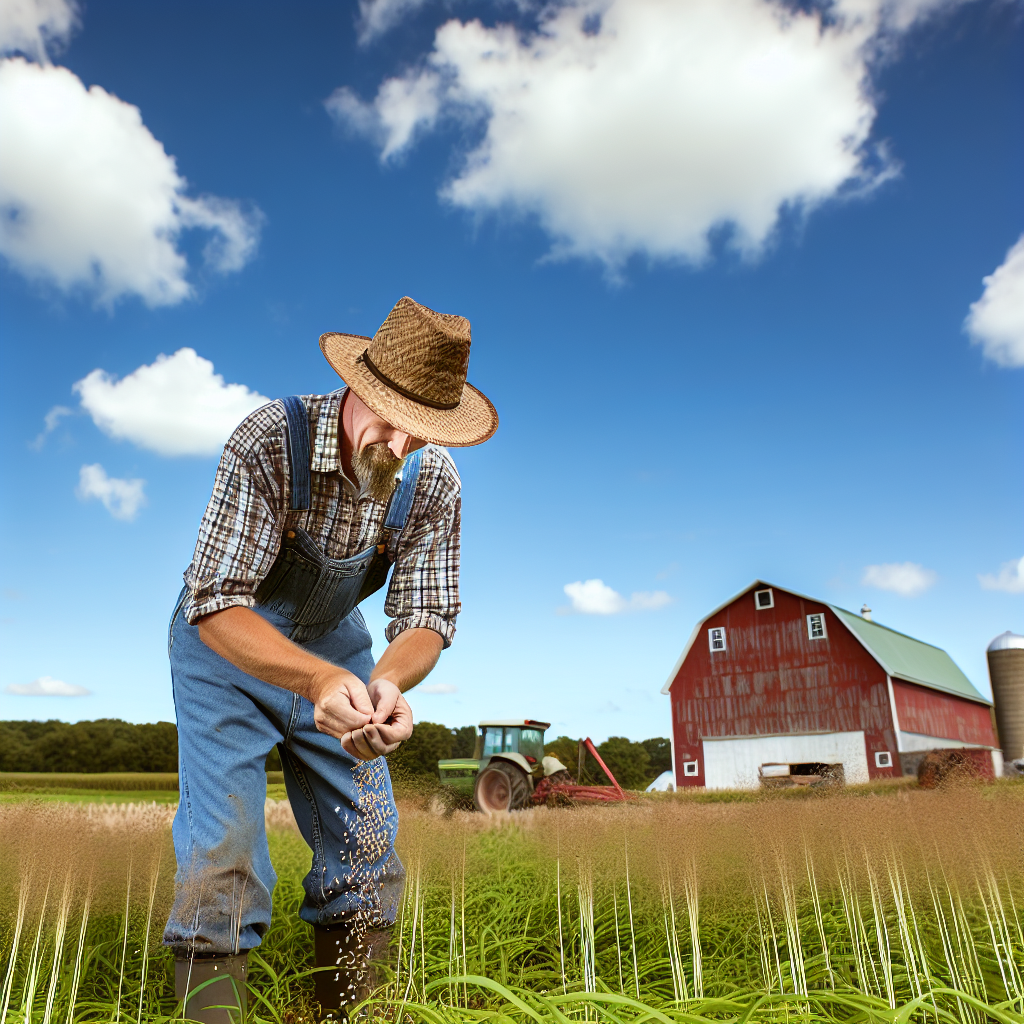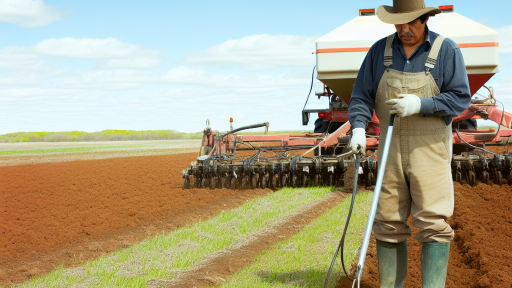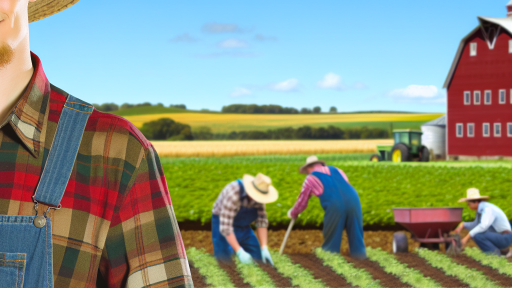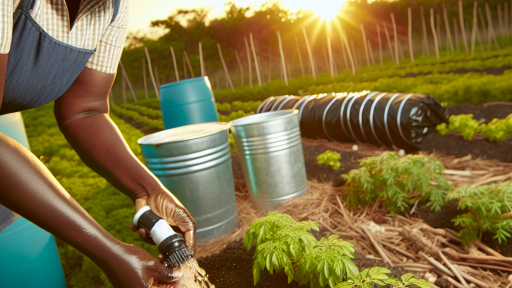Introduction to Cover Cropping
Importance of Cover Cropping
Cover cropping plays a vital role in organic farming.
It enhances soil health and stability.
Moreover, cover crops suppress weeds effectively.
They contribute to biodiversity in farming ecosystems.
Additionally, they prevent erosion during off-seasons.
Farmers can also improve nutrient cycling with cover crops.
Benefits of Cover Cropping for Organic Farming
Implementing cover crops has numerous advantages.
Firstly, they improve soil structure and fertility.
As a result, crops are healthier and more resilient.
Cover crops can also increase water retention in the soil.
This leads to reduced irrigation needs during dry periods.
Moreover, cover crops provide habitat for beneficial insects.
This can help control pests naturally.
Key Benefits of Using Cover Crops
- Enhances soil organic matter
- Reduces compaction and improves tilth
- Minimizes nutrient runoff
- Improves weed management strategies
- Supports soil microbial diversity
Hence, adopting cover cropping is beneficial for sustainable practices.
Farmers who utilize cover crops often see improved yields.
Transform Your Agribusiness
Unlock your farm's potential with expert advice tailored to your needs. Get actionable steps that drive real results.
Get StartedUltimately, these practices foster a healthier environment.
Common Types of Cover Crops
Legumes
Legumes are crucial in organic farming practices.
They enrich the soil by fixing nitrogen.
This process enhances soil fertility naturally.
Common legumes include clover, vetch, and peas.
Clover is particularly beneficial for weed suppression.
Additionally, vetch provides excellent biomass for soil improvement.
Grasses
Grasses play a vital role in soil health.
They improve soil structure and reduce erosion.
Some popular grasses are rye, oats, and barley.
Rye is known for its resilience during winter.
Moreover, oats can be a quick-growing option for summer planting.
Brassicas
Brassicas offer unique benefits in cover cropping.
Plants like radishes, turnips, and mustards are included.
These crops help break up compacted soil layers.
They also suppress pests and diseases effectively.
Radishes can grow deep taproots, improving soil aeration.
Selecting the Right Cover Crops for Different Soil Types and Climates
Understanding Soil Types
Soil types vary significantly across different regions.
Understanding the specific characteristics of your soil is crucial.
For instance, sandy soils drain quickly but hold fewer nutrients.
In contrast, clay soils retain water but may become compacted.
Loamy soils combine the best features of both sandy and clay soils.
Choosing cover crops can improve the overall health of each soil type.
Identifying Climate Conditions
Climate greatly influences which cover crops thrive.
Showcase Your Farming Business
Publish your professional farming services profile on our blog for a one-time fee of $200 and reach a dedicated audience of farmers and agribusiness owners.
Publish Your ProfileRegions with a warm climate often support an extended growing season.
Conversely, cooler climates may limit the types of viable crops.
It is essential to consider frost dates and rainfall patterns.
Understanding your local climate helps in selecting appropriate crops.
Selecting Cover Crops Based on Soil Type
Mixing different cover crops can benefit various soil types.
For sandy soils, deep-rooted plants aid in moisture retention.
Examples include chickpeas and sunflowers.
In clay soils, resilient plants can prevent compaction.
Consider options like vetch and winter rye.
These crops improve soil structure and enhance fertility.
Cover Crop Choices for Different Climates
Choosing the right cover crops for specific climates is vital.
In warm, dry regions, drought-tolerant varieties can be effective.
Sorghum-sudangrass is a good choice in these areas.
In humid climates, quick-growing species thrive.
Crops such as buckwheat and clover can succeed well.
These crops offer excellent ground cover and weed suppression.
Benefits of Cover Cropping
Cover cropping provides numerous benefits to soil health.
It helps in preventing soil erosion and nutrient runoff.
Moreover, cover crops improve soil fertility over time.
The roots of these crops contribute to organic matter.
Additionally, they can support beneficial soil microorganisms.
You Might Also Like: Natural Pest Control Methods for Organic Crops
Optimal Timing and Methods for Planting Cover Crops
Understanding Planting Timing
Planting cover crops requires careful timing for maximum benefits.
Consider the local climate when deciding when to plant.
Spring planting often promotes robust growth before summer crops.
In contrast, fall planting can enhance soil protection during winter.
Monitor soil temperatures to determine the ideal planting window.
Some cover crops, like clover, can withstand frost and thrive.
Selecting the Right Methods
Different methods exist for planting cover crops effectively.
Sowing seeds directly into soil can be effective for quick establishment.
Drilling seeds ensures even depth and spacing.
Broadcasting seeds is another option for larger areas.
Consider using a roller crimper for terminating existing vegetation.
Mechanical methods can help achieve better soil contact for seeds.
Evaluating Soil Conditions
Assessing soil conditions is crucial before planting cover crops.
Check for moisture levels to ensure adequate seed germination.
Soil composition affects the choice of cover crop species.
Use soil tests to identify nutrient needs for cover crop growth.
Healthy soil supports more robust cover crops and overall farm health.
Choosing the Right Cover Crop Species
Select suitable species based on your specific farming goals.
Showcase Your Farming Business
Publish your professional farming services profile on our blog for a one-time fee of $200 and reach a dedicated audience of farmers and agribusiness owners.
Publish Your ProfileLegumes help fix nitrogen in the soil, boosting fertility.
Grasses can improve soil structure and reduce erosion.
Mixing species can enhance diversity and resilience.
Consult local agricultural experts for tailored recommendations.
Implementing Crop Rotation Strategies
Crop rotation enhances the benefits of cover crops.
Switching species every season can disrupt pest cycles.
Rotation improves nutrient availability and improves soil health.
Plan rotations based on previous crop performance and cover crop benefits.
Document your rotations to analyze outcomes over time.
Utilizing Local Resources
Tap into local agricultural resources for support.
Extension services often provide guidance on cover cropping.
Local farmers can share valuable insights and experiences.
Networking with fellow farmers fosters community knowledge exchange.
You Might Also Like: Companion Planting Tips for Organic Crop Success
Integrating Cover Crops into Crop Rotation Systems for Improved Soil Health
The Role of Cover Crops
Cover crops play a vital role in enhancing soil health.
They prevent soil erosion and improve nutrient retention.
Additionally, cover crops enhance soil structure and prevent compaction.
Choosing the Right Cover Crops
Selecting appropriate cover crops is essential for successful integration.
Different species offer varying benefits to the soil.
For example, legumes fix nitrogen, enhancing soil fertility.
Brassicas, such as radishes, can break through compacted layers.
Therefore, consider soil type and specific farming goals when selecting crops.
Integrating Cover Crops into Rotation
Incorporating cover crops into crop rotations is straightforward.
Begin by planting cover crops after cash crops have been harvested.
Maintain cover crops through winter to maximize soil benefits.
In spring, terminate the cover crops before planting cash crops.
This sequence improves soil structure and nutrient availability.
Timing and Management Practices
Effective timing is crucial when managing cover crops.
Monitor growth stages to determine the best time for termination.
Employ methods such as mowing or rolling to destroy cover crops.
Moreover, incorporate cover crops into existing tillage practices wisely.
Benefits of Cover Cropping
Cover cropping provides numerous benefits that support sustainability.
It reduces soil erosion and increases organic matter levels.
Furthermore, improved soil structure leads to better water infiltration.
Consequently, these practices enhance overall farm productivity.
Challenges in Implementation
Despite their benefits, challenges exist in adopting cover cropping.
Farmers may face logistical issues, such as additional equipment needs.
Additionally, cover crops can require more management and planning.
However, ongoing education and resources can help mitigate these challenges.
Uncover the Details: Top Organic Farming Techniques for Successful Harvests
Showcase Your Farming Business
Publish your professional farming services profile on our blog for a one-time fee of $200 and reach a dedicated audience of farmers and agribusiness owners.
Publish Your Profile
Management Practices for Effective Termination of Cover Crops
Identifying the Right Time for Termination
Timing plays a crucial role in crop termination.
Farmers should monitor the growth stages of cover crops closely.
Optimal termination happens before flowering to minimize seed set.
Evaluate soil moisture and weather conditions prior to termination.
Such assessments help prevent soil degradation and promote crop health.
Choosing the Correct Termination Method
Different methods exist to terminate cover crops effectively.
Mechanical methods involve mowing or tilling.
These techniques can reduce biomass quickly and evenly.
Chemical methods involve applying herbicides to kill the crops.
It’s essential to choose suitable products that align with organic standards.
Implementing Best Practices for Termination
Proper termination methods optimize soil health and crop yield.
Rotate cover crop species to enhance soil nutrient diversity.
Consider using multiple termination methods for best results.
A combination of mechanical and chemical techniques may work effectively.
Additionally, foliage biomass should be well-distributed after termination.
Aftercare Following Termination
Post-termination care is vital for successful crop management.
Monitor soil health and assess any nutrient needs.
Incorporating terminated cover crops into the soil benefits soil structure.
Consider planting subsequent crops as soon as conditions allow.
This promotes continuous growth and minimizes soil exposure.
Discover More: Types of Cover Crops and Their Uses
Evaluating the Impact of Cover Cropping on Crop Yields and Soil Fertility
Importance of Cover Cropping
Cover cropping plays a crucial role in enhancing sustainable agriculture.
It improves soil structure and prevents erosion.
Furthermore, it helps in moisture retention, benefiting crops.
Impact on Crop Yields
Studies show that cover crops can increase overall crop yields.
They provide essential nutrients as they decompose in the soil.
Cover crops also suppress weed growth, reducing competition for resources.
Thus, they contribute to healthier and more productive crop systems.
Effects on Soil Fertility
Cover cropping significantly enhances soil fertility over time.
Leguminous cover crops, like clover, fix nitrogen in the soil.
This natural process enriches the soil for subsequent crops.
In addition, cover crops improve soil organic matter content.
Higher organic matter levels lead to better nutrient availability.
Long-Term Benefits
Implementing cover cropping offers long-term benefits for farming systems.
It promotes biodiversity, supporting various soil organisms.
Healthy soil promotes resilience against pests and diseases.
Moreover, cover crops help mitigate climate change impacts.
They store carbon, contributing to a reduction in greenhouse gases.
Best Practices for Implementation
Farmers should carefully select cover crops based on their specific goals.
It’s beneficial to rotate different species for optimal results.
Showcase Your Farming Business
Publish your professional farming services profile on our blog for a one-time fee of $200 and reach a dedicated audience of farmers and agribusiness owners.
Publish Your ProfileTiming is essential; cover crops should be planted at the right intervals.
Regular assessment of soil health can guide effective cover cropping.
- Choose appropriate species for local conditions.
- Monitor soil and crop health continuously.
- Adjust practices based on yield outcomes.
By following these practices, farmers can maximize the benefits of cover cropping.
Case Studies: Successful Implementation of Cover Cropping in Organic Farms
Farm A’s Journey with Cover Cropping
Farm A specializes in organic vegetable production.
They implemented cover cropping to improve soil health.
The farm chose clover and vetch for nitrogen fixation.
As a result, they noticed a significant increase in crop yield.
Moreover, the cover crops suppressed weeds effectively.
Farm A reported a decrease in herbicide use by 30%.
This method reduced overall farming costs.
Consequently, Farm A achieved a sustainable model for farming.
Farm B’s Diverse Cover Crop Strategy
Farm B focuses on grain production in a diverse cropping system.
They adopted a mix of radish and rye cover crops.
This mix improved soil structure and enhanced moisture retention.
The farm observed improved biodiversity in their fields.
Farm B saw an increase in beneficial insect populations.
Additionally, the diverse cover crops provided habitat for pollinators.
This approach resulted in higher yields of main crops.
Farm B’s method proved beneficial for both ecology and economy.
Farm C’s Innovative Cover Cropping Techniques
Farm C utilizes innovative techniques to enhance cover cropping.
This farm practices intercropping with cover crops.
They pair legumes with summer crops for nutrient enrichment.
The farm experienced less soil erosion during rain events.
Furthermore, the cover crops helped retain soil moisture.
Farm C also staged cover crop termination for optimal results.
This strategy maximized biomass production before main crops.
As a result, Farm C achieved remarkable improvements in soil health.
Farm D’s Community Focus
Farm D engages with the local farmer community on cover cropping.
They host workshops and share successful practices.
The farm collaborates with other growers for knowledge exchange.
This community aspect fosters innovation and adaptation of cover crops.
Farm D’s advocacy encourages others to adopt sustainable methods.
They have witnessed a positive shift in local organic farming.
Cover cropping has become a popular practice in their area.
Farm D’s efforts have contributed significantly to regional soil health.




